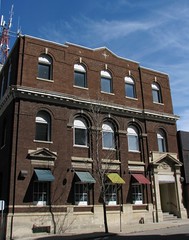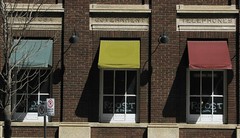This is a part two of my post about Brandon's New City Museum which recently opened
Manitoba Government Telephones Building at 19 - Ninth Street.
Brandon Daily Sun, December 28, 1901 (source)
By the turn of the century the telephone was being marketed to households as lines began to run to some rural centres around Brandon. To help the growth of the system, Bell dropped the price of a phone unit to about $6 per set and introduced half-price phone rates outside of business hours.
Telephone service first came to Brandon in 1882 when Bell Telephones set up shop on the prairies. That first year, it boasted a whole 51 customers clustered in the centre of the Wheat City. The expense of the new technology limited it mainly to business users.
The province found itself constantly butting heads with Montreal-based Bell over prices and the slow rate of expansion of its network. It soon realized that the only way they could keep up with the rest of the country, especially when it came to delivering service to thinly populated rural areas, was to do the work themselves.
In 1908, the Manitoba Government bought out Bell Telephone's holdings in the province, something that was also done by provincial governments in Saskatchewan and Alberta.
In Brandon, Manitoba Government Telephones (MGT) inherited 722 subscribers and the Bell telephone exchange building established around 1905 in a rented building at 31 – Ninth Street, just south of where the current building is.
The rapid expansion of the network required the construction of a larger, permanent telephone exchange building. The years came and went with no firm date set for construction.
There were a few reasons for MGT's delay. One was the sheer size of the project that they had taken on. Another was political meddling which sometimes influenced what communities got service improvements first. MGT was also keeping its eye on an emerging technology: the automatic telephone exchange.
Until this point, to make a telephone call you picked up the receiver and waited for the operator, (or "Hello Girl"), to answer and put your call through to the receiving party. For phone companies it meant that a small army of women were needed on-site at all times.
To keep up with the demand of the growing phone system in Brandon, MGT could wait no longer to act on a new telephone exchange building. A site was chosen immediately to the north of their rented premises and it bought 54 additional feet of land, (at an impressive $207 per foot), belonging to local real estate developer O.L. Harwood.
The contractor who won the bid to build the three-storey, $50,000 building was Hazleton and Wallis of Winnipeg.
The two men met and began building in Chicago before relocating to Winnipeg and had an impressive track record. They built a number of Winnipeg's iconic buildings, the YMCA on Vaughan (1913) and the Hamilton Bank on Main (1916-18), are just two examples that are still with us today. They pair also ventured outside the city, as far away as the Waddell Memorial Hospital in Canora, SK.
On August 2, 1916, work got underway on Brandon's new Telephone Exchange Building and it was completed sometime in December.
In 1908, the Manitoba Government bought out Bell Telephone's holdings in the province, something that was also done by provincial governments in Saskatchewan and Alberta.
In Brandon, Manitoba Government Telephones (MGT) inherited 722 subscribers and the Bell telephone exchange building established around 1905 in a rented building at 31 – Ninth Street, just south of where the current building is.
The rapid expansion of the network required the construction of a larger, permanent telephone exchange building. The years came and went with no firm date set for construction.
There were a few reasons for MGT's delay. One was the sheer size of the project that they had taken on. Another was political meddling which sometimes influenced what communities got service improvements first. MGT was also keeping its eye on an emerging technology: the automatic telephone exchange.
Until this point, to make a telephone call you picked up the receiver and waited for the operator, (or "Hello Girl"), to answer and put your call through to the receiving party. For phone companies it meant that a small army of women were needed on-site at all times.
As an example, in 1913, when an arsonist set fire to the Brandon telephone exchange sometime around 2 a.m., there was a chief officer and forty women on duty at the time. All escaped safely.
The above Brandon Sun story from September 1907 describes a typical day at the exchange, where 7,000 calls would be put through, as resembling a giant cribbage game.
To keep up with the demand of the growing phone system in Brandon, MGT could wait no longer to act on a new telephone exchange building. A site was chosen immediately to the north of their rented premises and it bought 54 additional feet of land, (at an impressive $207 per foot), belonging to local real estate developer O.L. Harwood.
The contractor who won the bid to build the three-storey, $50,000 building was Hazleton and Wallis of Winnipeg.
The two men met and began building in Chicago before relocating to Winnipeg and had an impressive track record. They built a number of Winnipeg's iconic buildings, the YMCA on Vaughan (1913) and the Hamilton Bank on Main (1916-18), are just two examples that are still with us today. They pair also ventured outside the city, as far away as the Waddell Memorial Hospital in Canora, SK.
On August 2, 1916, work got underway on Brandon's new Telephone Exchange Building and it was completed sometime in December.
Lobbyist ad by Automatic Telephone Mfg. Co., Liverpool England
March 11, 1912, Winnipeg Tribune
By the mid 19-teens, a couple of the automatic telephone systems being marketed around the world had stood the test of time and were becoming industry leaders.
In 1917, MGT finally decided that it would take the plunge and announced on April 20 that Brandon would be the first site in Manitoba to receive automatic telephones. They purchased a system by the Automatic Telephone Manufacturing Company of Liverpool, England. The equipment would be built in their Chicago facility and shipped to Brandon.
In late 1917, MGT went about the business of preparing the 1,794 Brandon and 497 rural customers for the changeover.
The most obvious difference would be in the telephone set itself. Instead of lifting a receiver that connected you to an operator there was now a rotary dial. At the exchange, a series of switches and relays would 'read' the number you dialed and patch through your call. (For an engineering manual on how an automated telephone exchange worked see Automatic Telephony from 1921).
Instructions appeared in telephone directories and the Brandon Sun did its part to let readers know how to handle the coming change. The above clip is from a November 1, 1917 article.
The Brandon Sun reported that the 1917 phone ownership rate in Brandon stood at 11.3%, which was impressive considering that for the country as a whole the rate was just 7.6%.
The western provinces led the Dominion in phone ownership. For instance, Manitoba's rate was a second-best 10.6% and BC had a country-leading 11.2% (source).
The most obvious difference would be in the telephone set itself. Instead of lifting a receiver that connected you to an operator there was now a rotary dial. At the exchange, a series of switches and relays would 'read' the number you dialed and patch through your call. (For an engineering manual on how an automated telephone exchange worked see Automatic Telephony from 1921).
Instructions appeared in telephone directories and the Brandon Sun did its part to let readers know how to handle the coming change. The above clip is from a November 1, 1917 article.
The Brandon Sun reported that the 1917 phone ownership rate in Brandon stood at 11.3%, which was impressive considering that for the country as a whole the rate was just 7.6%.
The western provinces led the Dominion in phone ownership. For instance, Manitoba's rate was a second-best 10.6% and BC had a country-leading 11.2% (source).
Jan 17, 1918 Manitoba Free Press
The project was completed just a few days later than scheduled.
At 5:00 a.m. on January 1, 1918, the lines were cut to the manual switchboards and thirteen minutes later Brandon customers were on the automatic system. On January 16, an open house was held for civic officials and MGT executives, including Harry Paterson the new Brandon phone superintendent.
Brandon was Manitoba's first 'automatic' telephone exchange city. By summer 1918, there were only a few other centres in the West that could boast the same.
Winnipeg didn't begin opening automatic exchanges until 1920 and it took six years until it was declared completely automated.
Winnipeg Telegram (Strike Edition) June 20, 1919
Not long after the opening of the new exchange there was labour strife at MGT.
In 1917, phone staff unionized and began demanding an increase in pay from their current $40 per month (for operators) and a reduction in their work day from ten to eight (source). Winnipeg's operators walked out for three hours but Brandon's stayed on the job.
In 1918, employees did get an increase in pay and changes to their work day.
When the Winnipeg General Strike began on May 15, 1919 it was the "Hello Girls" that were first to walk off the job. When Brandon held a sympathetic strike on May 20, again, it was the phone operators who were first to leave.
MGT threatened the striking workers that if they didn't return to their positions and sign a pledge never to take part in a sympathetic strike again they would be fired. The hiring of replacement workers began and on June 20 and MGT eventually fired all of their staff in favour of the replacements (source).
Phone service continued to expand in the city, but bureaucracy, wartime labour / equipment shortages, and the Depression slowed growth in rural areas.
The number of telephones in Manitoba, excluding Winnipeg, actually declined between 1920 and 1924, (source). That 11.3% phone ownership rate in Brandon in 1917 was only 53% by 1943, (source: Brandon's Politics and Politicians by W L Clark).
The Manitoba Government Telephones Building served Brandon until the late 1960s.
In 1966, MTS announced that a new $2 million building would be built at 18th and Victoria to house the latest in computerized switching and and microwave technology. When it opened in 1968, Brandon became the first centre in Manitoba to get touch tone dialing !

Top: First MGT car in Brandon ca. 1920s (Source: People of Service - see below)
Bottom: Phone truck in Reston ca. 1923 (source)
- A History of the Telephone in Manitoba MHS
- MTS Map of Long Distance Pole Routes (1940)
Resources
- Government telephones: The experience of Manitoba (1916)
- The invisible empire: a history of the telecommunications industry in Canada 1846 - 1956
- People of Service: A Brief History of the Manitoba Telephone System
- Private vs Public Telephones Wpg Real Estate News
For more Brandon history stories.




























1 comment:
It is interesting that in the very early days, the government saw the advantages in owning a telephone company, and now they do not.
Jim Petrin
Mavillette, N.S.
Post a Comment